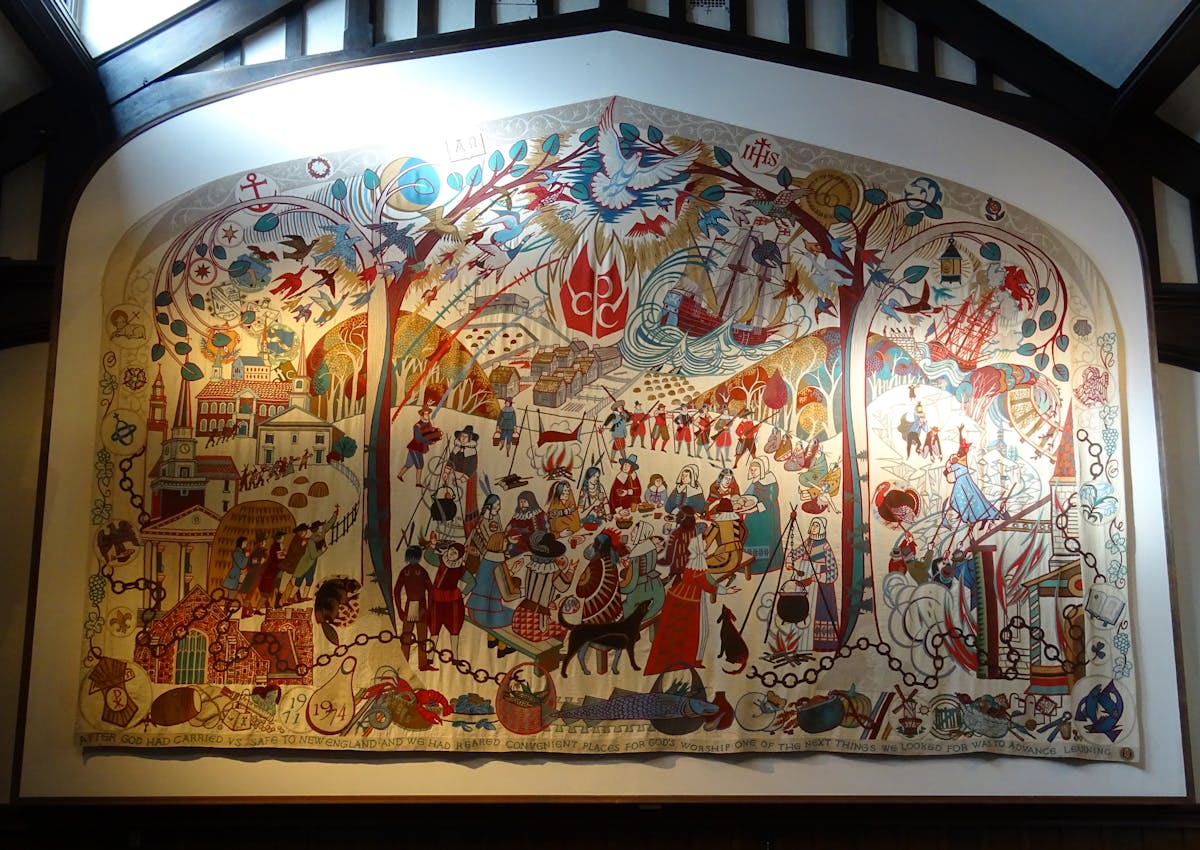Members of Plymouth Congregational Church in Minneapolis voted Sunday to no longer display a massive embroidery depicting the first Thanksgiving and a slave ship that church leaders deemed to be "disturbing and hurtful."
"We feel strongly that this was the right decision for the future of Plymouth," said Deb Fowler, former chairwoman of Plymouth's leadership council, which shared its embroideries action plan in May. "There's a tremendous sense of relief."
A group of church members had proposed an alternative plan that would keep the embroidery — one of four works created by a group of church women called the Needlers — on regular display while adding new artwork reflecting diversity and installing "informational panels" that give context and provide "words of repentance acknowledging our history."
Sunday's special meeting included a worship service before and after the vote, which members chose to do by secret ballot. Of 561 votes, 372 were to keep the existing plan, which includes keeping the embroidery down indefinitely.
Dobby West, who led those who wanted to display the embroidery, said he was disappointed by the decision, but "we felt very good that we were able to bring this issue to the congregation."
Some feared that permanent removal would discount the contribution of the Needlers, the women who met for years to sew the four works of art.
The work in question, titled "Churchmen in the New World," was first hung in 1974 and is part of a seasonal series that highlights key points in Congregationalist history.
In bright colors and careful stitches, it shows Pilgrims and Native Americans gathered at a table — part of the harmful Thanksgiving myth, some said — as well as a slave ship with people being led away.
The church's disagreement reflects a larger societal debate about the value of artwork that depicts painful historical events or outdated ideas and what should be done with it. Government buildings and museums have taken down, relocated, added context to or replaced pieces deemed racist or inaccurate.
As members filed out of the Gothic-style church, they expressed a range of reactions to the outcome.
Member Bob Carr said that although he thinks the church made the wrong decision, he acknowledged that it was a majority vote.
"It's throwing history and art under the bus, so to speak," he said.
Member Laura Tsai said that as a person of color, she understands the hurt on both sides. The vote makes her happy and hopeful, she said.
As the special meeting began Sunday morning, Beth Hoffman Faeth, the minister for congregational care and worship, welcomed both visitors and those who had returned after an absence.
"If you are a little confused about what's happening, I'm with you," she said, eliciting laughter.
Paula Northwood, acting senior minister, reminded the hundreds in attendance of their common ground, including a commitment to racial justice and a desire to make the church more welcoming. Everyone loves the church, she said, and "our Needlers."
"At the very least, we are going to find a way to agree to disagree and still love each other," she said.
Northwood reflected on how much churchgoers and leaders have learned and changed, even over the past two years. The church now houses homeless families; it supports a diverse range of speakers, theater and art, she said.
West shared details of the alternative plan, which "alleviates as much pain as possible without prioritizing one person's pain over another," he said, adding that it includes adding art that challenges the "Churchmen" embroidery.
"To view [the embroideries] only in terms of their unintended message … is wounding and turns the Needlers' sacrifice into something to be ashamed of," he said.
Using Roberts Rules, the congregation decided to vote by secret ballot. As the votes were tallied, members walked through the church and adjoining Guild Hall, enjoying refreshments and chatting casually.
While waiting for the results, Sonia Cairns expressed support for taking the embroidery off display, "which allows us to act on our values," she said. She worried that the church's ongoing search for a minister might be hindered if the artwork were to remain in rotation.
'A very strong church'
The reaction was muted as the vote totals were read. Afterward, the service continued for a short time.
Despite the emotion surrounding the vote, West said church members share virtually all the same goals and won't let this issue divide them.
"We have had major disagreements in the past," West said. "But the fact is, it's a very strong church."
Erin Adler • 612-673-1781

